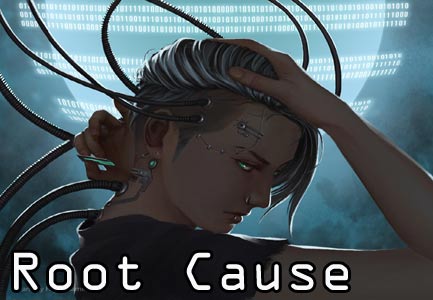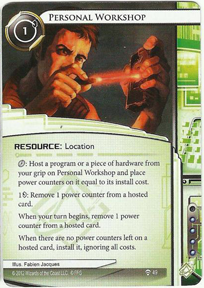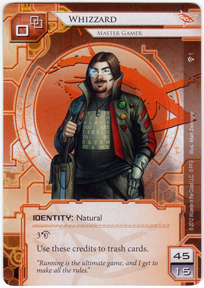Welcome to Card Game DB
Register now to gain access to all of our features. Once registered and logged in, you will be able to create topics, post replies to existing threads, give reputation to your fellow members, get your own private messenger, post status updates, manage your profile and so much more. If you already have an account, login here - otherwise create an account for free today!
Register now to gain access to all of our features. Once registered and logged in, you will be able to create topics, post replies to existing threads, give reputation to your fellow members, get your own private messenger, post status updates, manage your profile and so much more. If you already have an account, login here - otherwise create an account for free today!
Root Cause - Spending Influence
Apr 15 2013 01:05 PM |
Hraklea
in Android: Netrunner
Android: Netrunner Root Cause Hraklea Root Cause is a series of weekly Android: Netrunner articles about deck building, strategy and tactical decision, for new and mid-level Anarch players. It was named in honor of Samantha Groves, the character from the CBS' Person of Interest show played by Amy Acker.
Root Cause is a series of weekly Android: Netrunner articles about deck building, strategy and tactical decision, for new and mid-level Anarch players. It was named in honor of Samantha Groves, the character from the CBS' Person of Interest show played by Amy Acker.One of my favorite parts of card games is the deck building process. Whether in Android: Netrunner or games like Dominion, I spend a good amount of time thinking about what I could change in my deck to improve my chances of winning. Sadly, deck building is also one of the hardest things to learn in card games - it takes time, practice, patience.
In the first time trying to build your own deck (and everybody does exactly the same thing), you just pick your favorite cards and stack them together, as if it were supposed to work. After a while, you see that it actually doesn’t work that way. The problem becomes even worse when you realize that Fantasy Flight Games introduced this big freaking thorn in your side: the influence points system. You can’t ignore it, because one faction decks are too weak to be competitive, but it also prevents you from picking all your favorite cards to include in your deck.
Some players might get frustrated and just copy a high level player’s deck - why would you waste time trying to reinvent the wheel, right? Well, this option doesn’t satisfy everyone. Some players actually want to create their own deck, it provides that feeling of uniqueness that people expect in games like this. But time will show you that the right thing to do is to take the middle road: you don’t want to play something that’s not fun to you just because an experienced player told you it is good, and you also don’t want to play a deck that’s not competitive just for the sake of originality. This means, if you want to be a good Android: Netrunner player, you will need to learn some basic deck building skills, especially about how to properly spend your influence points.
Strategy is everything.
The first thing you need to maximize the effectiveness of your influence points is to set a goal for your deck. You want to win, of course, but how do you intend to do that? Which servers will you push? Will you control the opponent’s cash flow or will you build a strong rig to break whatever piece of ice your opponent can play? Once you have a game plan, you’ll be able to identify the needs and weaknesses of your deck, and that will tell you which out-of-faction cards you should pick.
Viruses: The Pure Breed
This is the most common archetype currently, playing a lot of virus program cards to take advantage from Noise: Hacker Extraordinaire (Core)’s ability, using Medium (Core) and Nerve Agent (Cyber Exodus) to force the opponent to protect his/her central servers. This deck popularity is due to its versatility, it can handle both corporation decks that focus on scoring agendas as fast as possible and corporation decks that focus on building a “super serverâ€. Since all the cards that define the strategy are already in-faction, you only need out-of-factions cards to support you (with credits, card drawings, etc.), to help you to play your virus program cards faster.
The flavor of the month here seems to be 2 copies of Personal Workshop (Cyber Exodus) (synergizes with Stimhack, Djinn and Wyldside) and 2 copies of Aesop's Pawnshop (Core) (synergizes with Imp, Liberated Account and again, Wyldside), usually filling the last 3 influence points with 3 copies of Easy Mark (Core). Other popular options include Diesel (Core), Test Run, Inside Job (Core), Magnum Opus (Core), and The Maker's Eye (Core).
The Big-Rig: A Shaper Approach
The so-called “big-rig decks†are designed not to win fast, but to play all your program and hardware cards fast, being particular strong against corporation decks that intent to win the game before you build your rig. Since Chaos Theory: Wünderkind was released, these Anarch decks have been losing ground to Shaper builds, but that doesn’t mean that the Anarch version is not competitive anymore - it just isn’t as popular as it used to be.
The most used out-of-faction card here would be Dinosaurus (Cyber Exodus), particularly to build the same combo used in Shaper decks: the well-known “Yog/saurusâ€, which allows you to break all code gate subroutines in the game for free (except for Tollbooth, which still requires you 3 credits). You can also host Mimic (Core) or Morning Star (What Lies Ahead) on Dinosaurus, if it is more convenient in a particular match up. If you want to use one of your Anarch consoles, you can include The Personal Touch (Core) and/or The Helpful AI (What Lies Ahead) to support your Icebreakers. Finally, Magnum Opus (Core) and Test Run (Cyber Exodus) are very effective here too, so you should always keep them in mind.
Credit Denial: A Criminal Approach
Since Whizzard: Master Gamer was released, a lot of players have been trying to make it work competitively. Some think they were successful and some are not satisfied with the results. Regardless of your opinion, it seems that the credit denial way is the right way with this identity card, using his ability to trash assets like PAD Campaign and Private Contracts, Imp (What Lies Ahead) to trash cards like Hedge Fund and Beanstalk Royalties, and Vamp (Trace Amount) to break your opponent’s economy down. This archetype is particularly strong against slow corporation decks, that rely on economy assets and upgrade to dominate the end of the game.
You want to borrow cards like Account Siphon (Core), Emergency Shutdown (Cyber Exodus), Cortez Chip (What Lies Ahead), Forged Activation Orders (Core) and Crescentus (A Study in Static) from Criminal to help you to bankrupt the opponent. You also should be - or already are - eargerly waiting for Xanadu (that should be released this month, in the Humanity’s Shadow data pack) that will really shine in this archetype.
Bad Match ups
Finally, you should always remember that your influence can and must be used to counter those specific cards (or strategies) that often ruin your day. Anarch has the worst tools in the game against trace attempts, it can’t handle damage properly, and some of its cards involve strong punishments when countered effectively.
Defensive cards are nice to fill those 1~3 influence points gaps that left after you picked the main out-of-faction cards that you want to use. Lemuria Codecracker (Core), Sacrificial Construct (Core), Compromised Employee (Trace Amount), Rabbit Hole (Core), Deus X (A Study in Static), etc. are great additions to do if you are having problems against a particular opponent. But that doesn’t mean that you should only consider 1 influence points cost cards. E3 Feedback Implants (Trace Amount) and Crash Space are great examples of 2 influence points cost cards that can be an important weapon in some matches.
What about you?
You might be wondering how my Anarch deck is and how the things I wrote were applied on its building. After all, when things are a little messed up, an example can be very helpful. My deck is a big-rig one. I really enjoy this strategy (I would say that I like Shaper as much as I like Anarch), and it has good results in my group. I started including 3 copies of Rabbit Hole, because trace attempts had been really dangerous and I had not felt like Disruptor would be enough to keep me safe from NBN players. After that, I decided to include 2 copies of ZU.13 Key Master (What Lies Ahead), because it wouldn’t cost any memory unit and it also synergizes very well with Stimhack; and 2 copies of Aesop’s Pawnshop, such an obvious call with Imp, Liberated Account, Armitage Codebusting, Wyldside, Rabbit Hole, and Underworld Contact, summing to 11 influence points spent.
With no need to include anything else, I decided to use the last 4 influence points for protection against the corporations that don’t rely on trace attempts to beat me: Haas-Bioroid and Jinteki. I first added 2 copies of Lemuria Codecracker, as exposing cards protects me from both traps (like Aggressive Secretary and Project Junebug) and pieces of ice that I can’t break (like Janus 1.0 and Data Mine), and the last 2 influence points became a single copy of E3 Feedback Implants, which is not necessary to win, but it can be really helpful.
Keep in mind that, no matter how many articles about deck building you read, nothing will ever replace practice. Even experienced players have to test their decks over and over. No one can predict every card interaction possible in a game that receives 20 new cards every month, so don’t get frustrated if your deck didn’t work out at the first trial. It took me one week playing 4 hours per day against the same guy until I won my very first match in a card game, and after a couple of months, the same guy was a free match for me. Don’t give up, and good luck!
João “Hraklea†Almeida is a brazilian amateur card game player. Started with Magic: the Gathering in 1999 and moved to different card games in 2004, including Pokémon TCG, Dragon Ball Z CCG and The Spoils. Currently playing only Android: Netrunner.
- Reager, Riwaine, admiralacf and 1 other like this



 Sign In
Sign In Create Account
Create Account













3 Comments
Nice read. I'm not really an Anarch player though. Just not my kind of faction.
I'm glad you guys liked it.